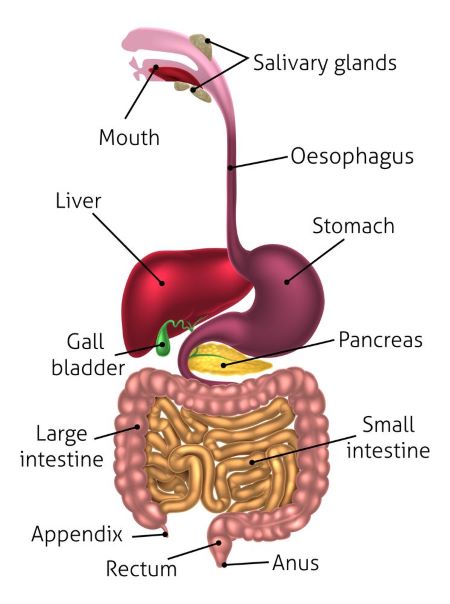Mastering Anatomic Systems Interaction Is Key to Learning A&P
Textbooks and the class syllabus often led students to approach human anatomy and physiology as if each anatomic system existed in isolation. Bu major body functions like control of blood pressure requires multiple anatomic systems interaction.
The body’s anatomic systems are crowded together, which is somewhat illustrated in the image below. Crowding is necessary for the watery chemistry underlying whole body communication to operate.
The Challenge: Moving Beyond Segregation to Anatomic System Integration
It’s tempting to think that if you can recite the major organs, pathways, and hormones of each system, you’re prepared for any exam. Yet, high-level questions—and real clinical reasoning—demand much more. Human physiology is a story of constant communication and feedback among anatomic systems. For example, when you eat a meal, your digestive tract isn’t working alone; neural signals, hormonal messengers, and changes in blood flow all interact to ensure nutrients are absorbed and delivered where needed.
Mechanisms Supporting Anatomic System Interfaces and Interactions
Every major function in the body is the result of collaboration among multiple anatomic systems. Let’s look at a few essential examples:
- Neural and Endocrine Coordination: The nervous system provides rapid, targeted signals—think reflexes or immediate adjustments in heart and respiratory rates at the onset of exercise—while the endocrine system delivers slower, longer-lasting hormonal messages that fine-tune processes like metabolism and endurance.
- Cardiovascular Support: No organ or tissue can function without oxygen and nutrients. The cardiovascular system responds to signals from both nerves and hormones to direct blood flow where it’s needed most, whether that’s your digestive tract after a meal or your muscles during exercise.
- Feedback Loops: Many body processes are regulated by feedback mechanisms. For instance, blood glucose control involves the pancreas (endocrine), and the liver (metabolic) working together to maintain blood levels of glucose within an optimal range.
Strategies For Mastering Anatomic System Interactions in Learning A&P
Understanding how anatomic systems interface is a skill that can be developed with intentional study techniques. Here’s how you can move beyond rote memorization and build a true integrative study plan:
- Practice the Three-Step Approach: For any process, ask yourself: What is the nervous system’s role? How does blood flow adapt? Which hormones are involved? This framework is not only effective for exams but also mirrors the way clinicians think about patient symptoms.
- Build Concept Maps: Use visual tools to draw connections between systems. Start with a central process (such as digestion or cardiac output) and branch out to show how each system contributes.
- Mixed Practice Questions: Don’t silo your review sessions. Test yourself with questions that require integrating knowledge from multiple systems. For example, explain how the body maintains blood pressure during sudden standing, considering neural, endocrine, and cardiovascular responses.
- Reflect and Revise: After each study session, jot down one way today’s topic connects to another system. Over time, these notes will reveal the interconnected nature of human anatomy and physiology.
Actionable Steps for Exam Success
To put these ideas into practice, try the following:
- Use a Dedicated Study Journal: Organize your notes by process rather than by system. The Busy Student’s Anatomy & Physiology Study Journal is designed to help you map complex system interactions and keep track of integrative exam questions.
- Self-Test Regularly: Create your own exam questions that require explanations of how two or more systems interact. Practice answering these aloud or in writing.
- Review Real-Life Scenarios: Apply your knowledge to clinical examples—such as how the body responds to dehydration or infection—to see system interactions in action.
Final Thoughts About Anatomic System Interaction
Mastering anatomy and physiology isn’t just about memorizing structures, it’s about seeing the body as a dynamic network of interacting systems. By focusing on anatomic system interaction, you’ll not only improve your exam performance but also lay the foundation for clinical reasoning and lifelong learning.
Further Reading
Improve Your Exam Scores in A&P
Gastrointestinal Tract Neural Regulation
Gastrointestinal hormones for Digestion and Fasting
Do you have questions or Comments?
Please put your questions in the comment box or send them to me by email at DrReece@MedicalScienceNavigator.com. I read and reply to all comments and email.
If you find this article helpful share it with your fellow students or send it to your favorite social media site by clicking on one of the buttons below.
Margaret Thompson Reece PhD, physiologist, former Senior Scientist and Laboratory Director at academic medical centers in California, New York and Massachusetts is now Manager at Reece Biomedical Consulting LLC.
She taught physiology for over 30 years to undergraduate and graduate students, at two- and four-year colleges, in the classroom and in the research laboratory. Her books “Physiology: Custom-Designed Chemistry”, “Inside the Closed World of the Brain”, and her online course “30-Day Challenge: Craft Your Plan for Learning Physiology”, and “Busy Student’s Anatomy & Physiology Study Journal” are created for those planning a career in healthcare. More about her books is available at https://www.amazon.com/author/margaretreece. You may contact Dr. Reece at DrReece@MedicalScienceNavigator.com, or on LinkedIn.
Dr. Reece offers a free 30 minute “how-to-get-started” phone conference to students struggling with human anatomy and physiology. Schedule an appointment by email at DrReece@MedicalScienceNavigator.com.




